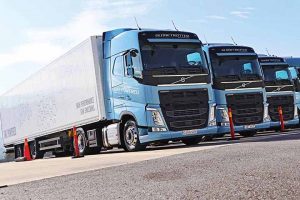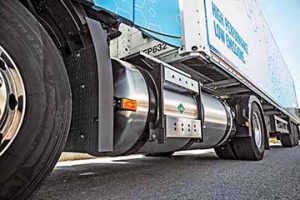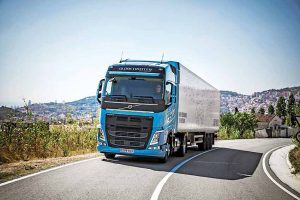Volvo is looking at gas as the fuel of future.
Story by:
Team CV
As the fuel of choice shows signs of increasing for CV operators, the electric phenomenon that hit the passenger car industry is starting to cross over to the heavy goods vehicle sector. Interesting times these are for the transport sector. Tesla has unveiled its battery operated semi-truck and Daimler has introduced the world’s first series production fully electric truck, the Fuso eCanter. If the Tesla Semi and the Fuso eCanter indicate that electric power is the only alternative, the same may not be the case after all. As an alternative to the tried and tested diesel trucks, few product introductions in the recent times have indicated that gas could be a credible medium indeed. Scania, for example, has been talking about CNG (Compressed Natural Gas). It has been doing it for sometime now. A few units with new specially designed gas-fed powertrains went into service late last year. Iveco has also released details of its CNG and LNG (Liquefied Natural Gas) vehicles. It is anticipating demand to pick up. The demand for gas is growing.
Volvo Trucks has invested significant resources into LNG power, and believes that it will lead to significant reductions in CO2 emissions as far as heavy goods vehicles are concerned. With its new, gas-powered FH and FM LNG variants, the Swedish major is not only confident of significant reduction in CO2, it is also confident that performance will not be sacrificed. Sources at Volvo Trucks are known to state that LNG could be a viable alternative to diesel. This would be especially true in the light of the incoming legislation, state sources. This would call for further reduction to emissions from vehicles, potentially saving operators in terms of the overall running costs. Volvo sources opine that there is an opportunity to make savings of up to 40 per cent considering the European prices for diesel and the LNG diesel equivalent price. Expressed Lars Mårtensson, Director of Environment and Innovation, Volvo Trucks, “Many of our customers, and their customers, are working hard to reduce their environmental footprint. This regulation will drive the development of lower emissions. We see a clear possibility of the LNG market share increasing as a vital part of the solution.” “Our vision is that Volvo trucks would eventually have zero emissions. The way to achieve the same is not by one single solution, but through several solutions in parallel.”
No stranger when it comes to alternative fuels, Volvo Trucks demonstrated ten years ago, seven trucks that ran on seven different fuels. Many of these innovations that the Swedish major demonstrated did not reach large-scale production. Sources claim that the time is right for LNG to realise its potential. It may be classed as a fossil fuel, the fact is, LNG can produce 20 per cent less CO2 emissions than diesel (tank-to-wheel). If biogas is used, the reduction could be as much as 100 per cent. In addition, one-kilogram of LNG has the same energy of 1.39 litres of diesel, meaning less fuel overall could be used on a journey. In Europe, close to 80 per cent of the goods are transported by road. Over 70 per cent of the journeys use long-haul or regional transport. Volvo, in such a scenario, sees a major opportunity to take LNG vehicles from the city and urban environments, where they have typically operated, to rural surroundings. Europe is said to have 3000 LNG trucks already. The count has doubled in the last three years. There are an estimated 100,000 LNG trucks in China. The US is said to have another five to 10,000 units. The trend is giving an impression of the industry picking up. It is set to continue in an environment where the search for an alternative to diesel is in full swing. The advantages of potential cost savings, and reduction in emissions look significant.
In infrastructure terms, LNG is work in progress. Progress is looking quick. Manufacturers are working with suppliers to enable a route to be established that would link the UK and Portugal. There are filling stations in the Netherlands, Belgium, France and Spain. Other countries with established stations, or plants that have been planned, include Italy, Switzerland, Poland, Sweden, Finland and Germany. Claim Volvo sources that an operator who covers 120,000 km (75,000 miles) and chooses natural gas for fuel will emit 18-20 million tonnes less CO2. They make a case for natural gas, the sources opine. Drawing attention to 264,000 heavy trucks having been registered in the EU, the sources mention, that the potential to significantly reduce emissions globally from heavy commercial traffic are high. “Bearing in mind that more than 264,000 heavy trucks were registered in the EU last year, there is immense potential to significantly reduce emissions globally from heavy commercial traffic. There is excellent availability of natural gas. It is competitively priced in many countries. LNG infrastructure is currently being expanded throughout Europe in accordance with the European Commission and member states’ action package for securing Europe’s long-term energy supply,” said Mårtensson.
With the new LNG models, Volvo wants to make things as straightforward as possible. Especially for the drivers. Describing the refuelling process as ‘different, but simple’ and cleaner because there is no grease, Volvo is looking at offering three types of refuelling modes – stationary, via a traditional fuel filling station, and on the move where a smaller unit that can be situated on different parts of the company’s premises or elsewhere. The ‘on the move’ mode could also include a tanker with a filling station at the rear. In case the driver runs out of fuel, a 50 bhp diesel engine on-board, will enable the drivers to reach safely, or to the nearest fuel station. From start to finish (including putting on, and taking off the safety clothing) it takes between five and 10 minutes, using equipment that is universal throughout countries and filling stations, claim Volvo sources. The performance curves for LNG models versus diesel being similar, the FH and FM LNG models mark the beginning of a journey that is different, unique and environmentally friendly. Offering marginally lower torque at lower rpm (800-1,000), the LNG trucks also offer marginally lower peak power output. Marking the beginning of a new journey that includes gas-powered regional and long-haul trucking, the Volvo FH and FM LNG employ advanced technologies such as the emergency braking technology VEB+ and I-See, and the company’s predictive cruise control system. Production of the LNG truck is scheduled for early 2018. Initial target market for sales is Europe.






















